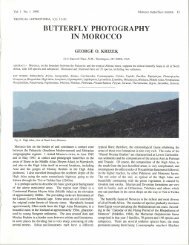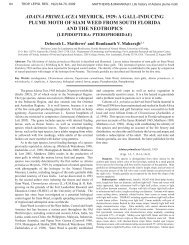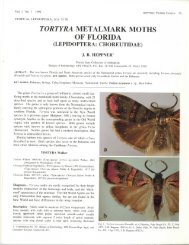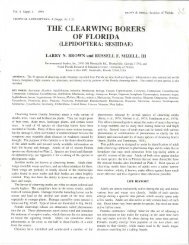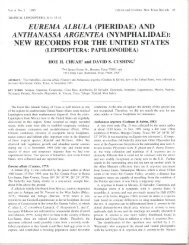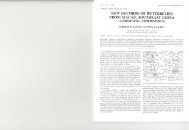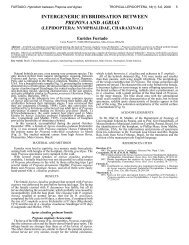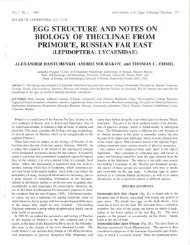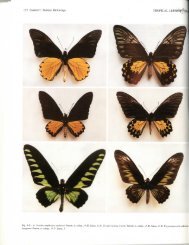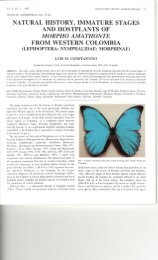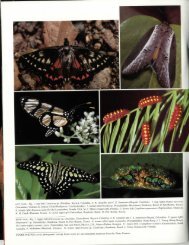biology and immature stages of the bromeliad pod borer, epimorius ...
biology and immature stages of the bromeliad pod borer, epimorius ...
biology and immature stages of the bromeliad pod borer, epimorius ...
- No tags were found...
Create successful ePaper yourself
Turn your PDF publications into a flip-book with our unique Google optimized e-Paper software.
Vol. 3 No. 1 1992 HEPPNER: Epimorius Immatures 57TROPICAL LEPIDOPTERA, 3(1): 57-62BIOLOGY AND IMMATURE STAGES OFTHE BROMELIAD POD BORER,EPIMORIUS TESTACEELLUS, IN FLORIDA(LEPIDOPTERA: PYRALIDAE: GALLERIINAE)J. B. HEPPNER1Florida State Collection <strong>of</strong> Arthro<strong>pod</strong>sBureau <strong>of</strong> Entomology, DPI, FDACS, P. O. Box 147100, Gainesville, FL 32614-7100, USAABSTRACT.- The <strong>biology</strong> <strong>and</strong> <strong>immature</strong> <strong>stages</strong> <strong>of</strong> Epimorius testaceellus Ragonot are described, as reared in Florida from flower <strong>pod</strong>s <strong>of</strong> <strong>the</strong> epiphytic<strong>bromeliad</strong>, Till<strong>and</strong>sia fasciculata Sw. (Bromeliaceae).KEY WORDS: Bleptina, Bromeliaceae, Cosmopterigidae, Eurytomidae, hostplant, Hymenoptera, Jamaica, larva, life history, Noctuidae, Opogona, pupa,Pyralis, Pyroderces, South America, Tineidae, Tortricidae, West Indies, Xylesthia.Fig. 1-2. Adults <strong>of</strong> Epimorius testaceellus Ragonot: 1. Male (FW = 9mm); 2. Female (FW = 11.5mm) (Palmdale, Glades Co., FL) (FSCA).The <strong>bromeliad</strong> <strong>pod</strong> <strong>borer</strong>, Epimorius testaceellus Ragonot, hasbeen known in Florida since possibly as early as 1960 (Heppner,1992), <strong>and</strong> recent reports have been published by Ferguson (1991)<strong>and</strong> <strong>the</strong> author (Heppner, 1992). The present paper elaborates onmy previous paper <strong>and</strong> gives fur<strong>the</strong>r notes on <strong>the</strong> larvae <strong>and</strong>pupae, including <strong>the</strong> first descriptions <strong>of</strong> <strong>the</strong>ir morphology. Firstdescribed from Jamaica (Ragonot, 1887), moths were reared from<strong>the</strong> <strong>bromeliad</strong>, Till<strong>and</strong>sia fasciculata Sw. (Bromeliaceae), inFlorida by <strong>the</strong> author in 1974, <strong>and</strong> subsequently identified <strong>and</strong>reported on by Ferguson (1991) after checking <strong>the</strong> holotypeillustrated by Ragonot (1901). The species occurs over much <strong>the</strong>1. Contribution No. 776, Bureau <strong>of</strong> Entomology, DPI, Florida Dept. Agric. <strong>and</strong>Consumer Services, Gainesville, FL.same distribution as <strong>the</strong> host: subtropical Florida <strong>and</strong> south into<strong>the</strong> West Indies <strong>and</strong> South America (Ferguson, 1991; Whalley,1964). As far as is known, this is <strong>the</strong> only species <strong>of</strong> Epimoriusoccurring in Florida. The larvae <strong>of</strong> this pyralid moth do considerabledamage to <strong>the</strong> flower <strong>pod</strong>s <strong>of</strong> infested <strong>bromeliad</strong>s, althoughpopulations appear to be localized <strong>and</strong> not very common inFlorida. No economic damage has been reported thus far, but alocalized outbreak could cause extensive damage if mothpopulations built up to high enough numbers. The moth does notappear to be responsive to light traps, since few if any adultspecimens have been collected in Florida o<strong>the</strong>r than throughrearing from larvae.
58 HEPPNER: Epimorius Immatures TROPICAL LEPIDOPTERAFig. 3-8. Larval morphology: 3. Head front view <strong>and</strong> chaetotaxy; 4. Same, lateral view; 5. Labrum front view; 6. Same, venter; 7. Left m<strong>and</strong>ible, venter; 8. Hypopharynxcomplex, with labium <strong>and</strong> maxillae morphology, (scale lines =, 0.2mm)
Vol. 3 No. 1 1992 HEPPNER: Epimorius Immatures 59VI /T1 T2 A1 A6 A8 A91011Fig. 9-11. Larval chaetotaxy: 9. Chaetotaxy map; 10. Detail <strong>of</strong> crochets on proleg (ventral view); 11. Dorsal view <strong>of</strong> posterior segments <strong>of</strong> abdomen.LARVAL MORPHOLOGYFig. 3-11 illustrate details <strong>of</strong> <strong>the</strong> larval morphology <strong>of</strong> E.testaceellus. Last instar larvae average 14.8mm in length (n = 3).Description- HEAD: rounded head capsule dark amber in color (Fig.3-4); frons triangular, ca. 2x length <strong>of</strong> short epicranial suture; adfrontalsetae present, as much separated as API is from adfrontal suture base;frons setae absent <strong>and</strong> only pores Fa present; Cl prominent; stemmatain circle <strong>of</strong> 6, about evenly spaced; PI close to P2; MD1 closer to MD2than MD3 is to MD2; MDa midway betwen MD2 <strong>and</strong> MD3; Al-3 infairly tight triangle near stemmata; LI high in relation to PI <strong>and</strong> nearlyas close to PI as to A3; LI prominent; SI near center <strong>of</strong> stemmatacircle; S2 closer to stemma 1 than to stemma 6; SS2 near stemma 6; SSI<strong>and</strong> SS3 close toge<strong>the</strong>r; MG1 distant from SS2. Labrum (Fig. 5-6) with4 setae near center <strong>and</strong> 4 along margin <strong>of</strong> each comer; ridge belowcentral setae; venter with 3 setae each side <strong>of</strong> strongly sclerotizedmedian ridge. M<strong>and</strong>ibles (Fig. 7) with 4 major teeth evident; lateralmargin with 2 large setae. Hypopharynx (Fig. 8) with strong sclerotizationon labium.BODY: (Fig. 9-11) with secondary setae absent; integument relativelysmooth <strong>and</strong> a golden yellow, with pinacula slightly darker shade;pinacula rings not evident; most pinacula on elevated integumentalplates. Thorax with Tl showing long XD1 <strong>and</strong> XD2 setae, SD1 closeto SD2, LI <strong>and</strong> L2 approximate on same pinaculum, <strong>and</strong> SV1 <strong>and</strong> SV2approximate on single pinaculum; T2 with Dl <strong>and</strong> D2 small, SD2 onedge <strong>of</strong> SD1 pinaculum, Ll-3 hi straight row angled up to L3, <strong>and</strong> SV2minute. Abdomen with prolegs an A3-6 <strong>and</strong> A10, with crochets (Fig. 10)in triordinal circles; Al with Dl <strong>and</strong> D2 prominent, SD1 <strong>and</strong> SD2 onapproximate pinacula, L3 separate from approximate Ll-2, <strong>and</strong> SV1-3close toge<strong>the</strong>r; A2-6 similar to Al; A7-8 same but with SV3 absent <strong>and</strong>SD1 <strong>of</strong>f pinaculum <strong>of</strong> small SD2; A9 with SD1 distant from Dl, L3close to Ll-2, <strong>and</strong> SV2-3 absent; A10 (Fig. 11) with large dorsal plateforDl-2<strong>and</strong>SDl.
60 HEPPNER: Epimorius Immatures TROPICAL LEPIDOPTERA13 14Fig. 12-14. Pupal morphology: 12. Pupa, lateral view; 13. Detail <strong>of</strong> dorsal segments <strong>of</strong> abdomen; 14. Details <strong>of</strong> posterior segment <strong>of</strong> abdomen, oblique <strong>and</strong> ventralPUPAL MORPHOLOGYFig. 12-14 illustrate details <strong>of</strong> <strong>the</strong> pupa <strong>of</strong> E. testaceellus. Size:9.2mm (n = 1).Description.- Pyraloid configuration, with protruded spriacles on A2-3;dorsum <strong>of</strong> abdominal segments with strongly sclerotized ridges (Fig. 13),with a large seta on each side (sometimes a smaller one as well);terminal segment <strong>of</strong> abdomen with pronounced cup-like protrusion withsharp lateral points <strong>and</strong> side spur (Fig. 14); ultimate 2 segments withdorsal setae having small hook-tips.HOST.- Thus far, <strong>the</strong> only confirmed host <strong>of</strong> E. testaceellus is<strong>the</strong> large <strong>bromeliad</strong>, Till<strong>and</strong>sia fasciculata. There is an FSCArecord <strong>of</strong> basal leaf damage to Till<strong>and</strong>sia valenzuelana A.Richard, from Copel<strong>and</strong>, Collier Co., in Jan 1976 (V. W. Yingst,collector), but <strong>the</strong> moth species is not confirmed as being E.testaceellus <strong>and</strong> probably is ano<strong>the</strong>r pyralid species.BIOLOGYIn addition to <strong>the</strong> rearings from <strong>the</strong> Fisheating Creek area,Palmdale, Glades Co., in May 1974 (JBH 74E5) <strong>and</strong> May 1975(JBH 75E10), <strong>the</strong> author also reared <strong>the</strong> moth from larvae foundat Ma<strong>the</strong>son Hammock, Miami, Dade Co., in Jan 1974 (JBH74A2), <strong>and</strong> near <strong>the</strong> Archbold Biological Station, 6 mi SE LakePlacid, Highl<strong>and</strong>s Co., in May 1975 (JBH 75E8). A more recentrecord is from Miami, in Mar 1981 (E. Pena, collector). Earlierrecords from FSCA files include a larvae collected Mar 1960from a <strong>bromeliad</strong> in Ft. Lauderdale, Broward Co. (J. M. Soowal,collector), <strong>and</strong> a pyralid flower <strong>pod</strong> <strong>borer</strong>, which may be thissame species, collected Jul 1964, in Ft. Lauderdale (D. McKean,collector).Larval feeding by E. testaceellus involves excavations fromfeeding inside individual flower <strong>pod</strong>s (or capsules) <strong>of</strong> <strong>the</strong> largeflower spikes <strong>of</strong> <strong>the</strong> hostplant, Till<strong>and</strong>sia fasciculata, a strictlyepiphytic <strong>bromeliad</strong> (Langdon, 1981). Larval damage is evidentby frass ejected from <strong>the</strong> flower capsule <strong>and</strong> discoloration <strong>of</strong> <strong>the</strong>infested flower spikes (Fig. 16). A large <strong>bromeliad</strong> will have 10or more flower spikes in each inflorescence (Fig. 15), <strong>and</strong> eachspike may have 2-3 larvae feeding on several <strong>of</strong> <strong>the</strong> individualflower <strong>pod</strong>s (Fig. 16). Several flower <strong>pod</strong>s are usually consumedby each larva.
Vol. 3 No. 1 1992 HEPPNER: Epimorius Immatures 61Fig. 15-16. Hostplant damage from Epimorius testaceellus: 15. Mature <strong>bromeliad</strong> (Till<strong>and</strong>sia fasciculata); 16. Larval damage (1 larva visible in opened flower capsule)(Palmdale, FL). © J. B. Heppner.Pupation is within <strong>the</strong> shell <strong>of</strong> an excavated flower <strong>pod</strong>, usuallytoward <strong>the</strong> apex <strong>of</strong> a flower inflorescence <strong>and</strong> near a spike base.A silken cocoon is spun against <strong>the</strong> capsule walls <strong>and</strong> an exit holeis partially chewed on an exterior wall near <strong>the</strong> <strong>pod</strong> base, leaving<strong>the</strong> adult to push a thin plant flap upon emergence. The head <strong>of</strong><strong>the</strong> pupa is placed just beneath <strong>the</strong> exit hole <strong>of</strong> <strong>the</strong> flowercapsule. Pupation lasts about 17 days during <strong>the</strong> winter <strong>and</strong> 6-14days during May (n = 5). Adults emerge early evening, 7-8 PM.Adults are known thus far only for Jan-Feb <strong>and</strong> May, but since<strong>the</strong> hostplants in a given area have 3-4 flowering periods per yearin south Florida, <strong>the</strong> moths also probably have 3-4 generationsper year (probably Feb, May, Aug, Nov, being months <strong>of</strong> adultactivity, at least in <strong>the</strong> Miami area).Among <strong>the</strong> <strong>bromeliad</strong> moth micro-fauna that has thus far beenreported from Till<strong>and</strong>sia fasciculata in Florida, in addition to E.testaceellus, species which might be confused with it include <strong>the</strong>detritus-feeder, Pyralis farinalis (Linnaeus) (Pyralidae: Pyralinae);<strong>the</strong> stem <strong>and</strong> detritus-feeder, Opogona sacchari (Bojer) (Tineidae);<strong>the</strong> detritus-feeder, Xylesthia pruniramiella Clemens(Tineidae); a detritus-feeding Cosmopterigidae (probably Pyrodercessp.); a Tortricidae flower-feeder (sp. unknown); <strong>and</strong> a deadleaffeeding Noctuidae (Bleptina sp.). However, <strong>the</strong>re appear tobe no moth larvae with feeding habits similar to E. testaceellusin <strong>the</strong>se <strong>bromeliad</strong>s. The only recent study <strong>of</strong> <strong>bromeliad</strong> Lepidopterafaunas, in Mexico, did not discover any Pyralidae species(Beutelspacher, 1972a, 1972b).Bugbee (1975, 1976) reported on a new <strong>and</strong> relatively largeorange Eurytomidae parasitoid, which he named Eurytomaaerflora, <strong>and</strong> which was reared by <strong>the</strong> author from both <strong>the</strong>Palmdale <strong>and</strong> Miami rearings <strong>of</strong> E. testaceellus.ACKNOWLEDGMENTSReared moths from Florida were sent a number <strong>of</strong> years ago toDr. D. C. Ferguson, USDA, SEL, c/o USNM, Washington, DC,for identification, <strong>and</strong> his efforts over several years to determine<strong>the</strong> name <strong>of</strong> <strong>the</strong> species, resulting in his recent paper on <strong>the</strong> genus(Ferguson, 1991), are greatly appreciated. Larval rearings wereconducted while <strong>the</strong> author was a graduate student in 1974-75 at<strong>the</strong> University <strong>of</strong> Florida, Gainesville, with support from <strong>the</strong>Department <strong>of</strong> Entomology <strong>and</strong> Nematology, Institute <strong>of</strong> Food<strong>and</strong> Agricultural Sciences; Dr. D. H. Habeck, graduate advisor.LITERATURE CITEDBeutelspacher, C. R.1972a. Fauna de Till<strong>and</strong>sia caput-medusae E. Morren, 1880 (Bromeliaceae).Anal. Inst. Biol. UNAM. (Mexico City), (Zool.)43(1):25-30.1972b. Some observations on <strong>the</strong> Lepidoptera <strong>of</strong> <strong>bromeliad</strong>s. J.Lepid. Soc. (Los Angeles), 26:133-137.Bugbee, R. E.1975. A new species <strong>of</strong> <strong>the</strong> genus Eurytoma (Hymenoptera: Eurytomidae)from a pyralid occurring in <strong>the</strong> flower <strong>pod</strong>s <strong>of</strong> Till<strong>and</strong>siafasciculata. J. Georgia Ent. Soc. (A<strong>the</strong>ns), 10:91-93.1976. Description <strong>of</strong> <strong>the</strong> male <strong>of</strong> Eurytoma aerflora Bugbee (Hym.:Eurytomidae). /. Georgia Ent. Soc. (A<strong>the</strong>ns), 11:181-182.Ferguson, D. C.1991. Review <strong>of</strong> <strong>the</strong> genus Epimorius Zeller <strong>and</strong> first report <strong>of</strong> <strong>the</strong>occurrence <strong>of</strong> E. testaceellus Ragonot in <strong>the</strong> United States(Pyralidae: Galleriinae). J. Lepid. Soc. (Los Angeles), 45:117-123.
^62 HEPPNER: Epimorius ImmaturesHeppner, J. B.1992. Bromeliad <strong>pod</strong> <strong>borer</strong>, Epimorius testaceellus (Lepidoptera:Pyralidae: Galleriinae). Fla. Dept. Agric. Consumer Serv.,Div. Plant Indus., Ent. Circ. (Gainesville), 351:1-2.Langdon, K. R.1981. The native Rorida <strong>bromeliad</strong> or wild-pine, Till<strong>and</strong>sia fasciculata.Fla. Dept. Agric. Consumer Serv., Div. Plant Indus.,Botany Circ. (Gainesville), 15:1-2.Ragonot, E. L.1887. Diagnoses <strong>of</strong> North American Phycitidae <strong>and</strong> Galleriidae.Paris: Ragonot. 20 pp.1901. Monographic des Phycitines et des Galleriinae. In Mem.Lepid. (St. Petersburg), 8:1-602, 34 pi.Whalley, P. E. S.1964. Catalogue <strong>of</strong> <strong>the</strong> Galleriinae (Lepidoptera, Pyralidae) withdescriptions <strong>of</strong> new genera <strong>and</strong> species. Acta Zool. Cracov.(Krakow), 9:561-618, pi. 14-44.TROPICAL LEPIDOPTERA



